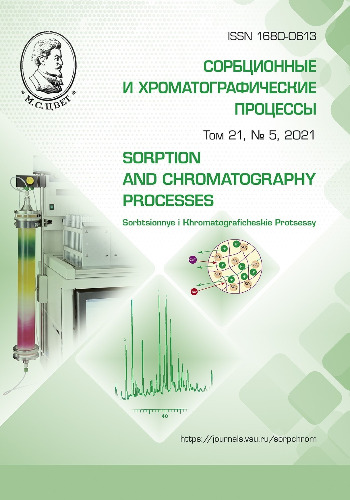The use of chromatographic methods for the purification of glutathione reductase from rat livers with experimental type 2 diabetes
Abstract
The aim of our study was to determine the activity of glutathione reductase (EC 1.6.4.2) from rat livers with experimental type 2 diabetes and rats who had a pathology and were dosed with SkQ1. We also aimed to develop a scheme of enzyme purification by means of chromatographic methods. In our experiment, we used rat livers from the animals in the control group, rats with streptozotocin-induced type 2 diabetes (2D) and rats with experimental hyperglycemia dosed with 10-(6'-plastoquinonyl) decyltriphenylphosphonium (SkQ1). 2D was induced by a combination of 1-month high-fat diet and a subsequent double intraperitoneal injection of streptozotocin with a 7-day interval. The dosage of streptozotocin was 30 mg per 1 kg of a rat’s weight in a citrate buffer, рН 4.4. SkQ1 was injected as a 1250 mmol/kg/day solution every morning starting with the second week of the experiment. The activity of GR was determined spectrophotometrically using a spectrophotometer SF-46 at a wavelength of 340 nm. The total amount of protein was determined by the Lowry method. The study demonstrated an increase in the activity of GR in the livers of rats with streptozotocin-induced 2D as compared to the control group. It also showed that the SkQ1 injections administered to rats with pathology resulted in a decrease in the activity of the studied enzyme. Using ammonium sulfate precipitation, gel filtration through G-25, and ion exchange chromatography on DEAE-cellulose, we obtained 56.5, 45.57, and 52.9 times purified GR enzyme preparations from the livers of rats in the control group, rats with streptozotocin-induced 2D, and rats with experimental hyperglycemia dosed with SkQ1. The study demonstrated that during the ion exchange chromatography on DEAE-cellulose, the desorption of the main pool of the enzyme extracted from the rats in the control group was observed when using KCl with the concentration of 100 mmol/dm3. The same happened during the purification of the enzyme from the livers of rats with experimental hyperglycemia when using KCl with the concentration of 50 mmol/dm3. When using SkQ1 as a protector in the presence of pathology, the GR pool, which was desorbed from DEAE-cellulose when using KCl with the concentration of 100 mmol/dm3, increased compared to the pathology. This can be explained by the changes in the net charge of the molecule of the studied enzyme under oxidative stress resulting from hyperglycemia.
Downloads
References
Ghasemi-Dehnoo M., Amini-Khoei H., Lorigooini Z., Rafieian-Kopaei M., Asian Pac J Trop Med., 2020, Vol. 13, pp. 431-438.
Chandra K., Singh P., Dwivedi S., .Jain S., Journal of clinical and diagnostic re-search, 2019, Vol. 13, pp. BE07-BE12
Chikezie P.C., Ojiako O.A., Agomuo C., International Journal of Biological Chemis-try, 2015, Vol. 9, pp. 71-79.
Verma S., Sagar N., Vats P., Int J Bioas-says, 2013, Vol. 2, pp. 685-690.
Zanozina O.V, Borovkov N.N., Shherbatyuk T.G., Sovremenny`e tekhnologii v meditsine, 2010, No 3, pp. 104-112.
Inoguchi T., Li P., Umeda F., Yu H., Kakimoto M. et al., Diabetes, 2000, Vol. 49, pp. 1939-1945.
Tkachuk V.A., Vorotnikov A.V., Sakharny`j diabet, 2014, Vol. 17, No 3, pp. 29-40.
Pashenczeva A.V., Verbovoj A.F., Sharonova L.A., Ozhirenie i metabolism, 2017, Vol. 14, No 2, pp. 9-17.
Mishina E.E., Majorov A.Yu., Bo-gomolov P.O., Maczievich M.V. et al., Sakharny`j diabet, 2017, No 5, pp. 335-342.
Tiwari B.K., Pandey K.B., Abidi A.B., Rizvi S.I., J Biomark, 2013, Vol. 2013, pp. 1-8.
Lovat` M.L., Avrushhenko M.Sh., Averina O.A., Pavshinczev V.V., Obshhaya reani-matologiya, 2016, Vol. 12, No 2, pp. 6-18.
Roginsky V.A., Tashlitsky V.N., Sku-lachev V.P., Aging., 2009, Vol. 1, pp. 481-489.
Yurova M.N., Zabezhinskij M.A., Piskunova T.S., Ty`ndy`k M.L. et al., Uspekhi gerontologii, 2010, Vol. 23, No 3, pp. 430-441.
Zinovkin R.A., Popova E.N., Pletyushkina O.Yu., Il`inskaya O.P. et al., Obshhaya reanimatologiya, 2018, No 2, pp. 69-86.
Agarkov A.A., Popova T.N., Boltysheva Y.G., World J Diabetes, 2019, Vol. 10, No 12, pp. 546-559.
Zhang M., Lv X.Y., Li J., Xu Z.G. et al., Journal of Diabetes Research, 2008, Vol. 2008, pp. 1-9.
Agarkov A.A., Semenihina A.V., Rahmanova T.I., Popova T.N. et al., Vestnik VGU, seriya: himiya, biologiya. farmaciya, 2007, No 2, pp. 59-63
Selemenev V.F., Rudakov O.B., Slavin-skaya G.V., Drozdova N.V., Pigmenty` pishhevy`kh proizvodstv (melanoidy`), M., DeLi print, 2008, 246 p.
Kramarenko V.F., Toksiko-logicheskaya khimiya, M., Kniga po Trebovaniyu, 2013, 445 p.
Lowry O.N., Rosebrough N.J., Farr A.L., Randall R.J., J. Biol. Chem., 1951, Vol. 193, pp. 265-275.
Llojd E`., Lederman U., Spravochnik po prikladnoj statistike, M., Finansy` i statis-tika, 1990, 526 p.
Kurilova L.S., Kruteczkaya Z.I., Leb-edev O.E., Antonov V.G., Czitologiya, 2008, Vol. 50, No 5, pp. 452-461.
Rabinovich S.E`., Shono N.I., Platonova L.V., Dyuzheva T.G. et al., Biomediczinskaya khimiya, 1997, Vol. 43, pp. 104-111.
Pai E.F., Schulz G.E., J Biol Chem., 1983, Vol. 258, pp. 1752-1757.
Voronkova Y.G., Popova T.N., Agarkov A.A., Zinovkin R.A., Biochemistry, 2015, Vol. 80, pp. 1614-1621.







